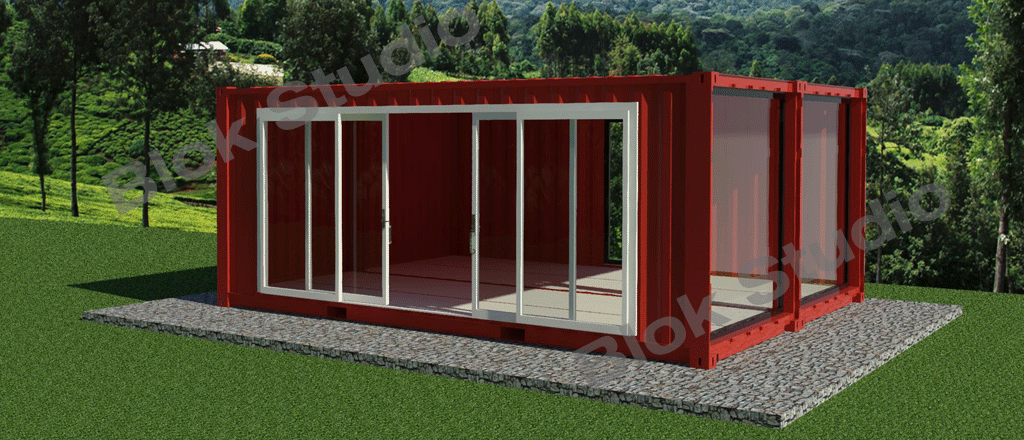
WHO WANTS TO LIVE/WORK IN A STRUCTURE THAT LOOKS LILKE A CARGO CONTAINER?
A- Most of the homes/structures do not look like a Shipping Container. The ISBU is only the super-structure shell. It can be covered with anything used in traditional construction -wood, stucco, vinyl siding, limestone, shingles, brownstone, brick and aluminum siding. Second, the Cargo Container look is also becoming a bit trendy and some prefer all or part of the home/structure to
remain natural.
ARE CONTAINER HOMES/STRUCTURES LESS EXPENSIVE?
A- Yes. In most occasions, you’ll save about 20%-25% from traditional stick built construction. Structures can range from simple to complex. Costs increase based on complexity of design and scope of work to perform.
HOW LONG DOES IT TAKE TO BUILD ONE?
A-The build process takes approximately 6-8 weeks for our prefab design upto 640sf with standard finish options. Custom build units can take longer. Much faster than traditional construction though. The permit process will vary upon the local code approval.
WHAT ABOUT CODES AND ZONING?
A-Codes and zoning will differ depending on the City/County that the unit will be placed and how it will be secured. Typical building code options are Factory Built Housing (FBH), Housing & Urban Development (HUD), and Tiny Home on Wheels (THOW). We work with your respective planning office to ensure compliance before building begins.
WHAT SIZES ARE OFFERED?
A-The measurements of the containers are generally categorized by their length and two options for height.
“Standard” = 8’6” or “High-cube” = 9’6”
20’ Long x 8’ Wide = 160 sf
40’ Long x 8’ Wide = 320 sf
45’ Long x 8’ Wide = 360 sf
Other sizes of containers are available such as 8′, 10′ and 53′. These are specially made but are a minority.

DO SHIPPING CONTAINERS GET VERY HOT OR COLD INSIDE?
A: No! Sure, if you don’t know what you’re doing and don’t insulate. The units are insulated using a combination of eco-BAT or closed-cell insulation and multi-ceramic thermal reflection exterior coatings (walls R-19, ceilings R-38). Our insulation practices typically meet or exceed most building requirements. In fact, if you build a home, office, emergency shelter or storage unit using Ceramic Insulation Paint (spray) the structure will probably be more energy efficient than a conventional home. Included AC/Heat provides cool air on hot summer days, and warm air on cold northern winter days.
WHAT ABOUT RUST AND CORROSION ON A SHIPPING CONTAINER?
A- No. Remember, an ISBU is a Shipping Container used for ocean shipping, humidity and saltwater. A shipping container is a special, non corrosive Corten steel; then, when coated with the Ceramic Insulation Paint, it becomes virtually rust proof and also prevents mildew,
mold and is highly antiseptic.
ARE CONTAINER STRUCTURES SAFE?
A- Yes, ISBU (Inter-Modal Steel Building Unit) Homes can withstand 100 MPH winds on a foundation, or 175 MPH winds when easily anchored with pylons. Very solid in Tornados or Hurricanes. It would be the most perfect safety cocoon in an Earthquake. Even in a direct hit, the structure my possibly roll around a little but certainly not collapse. It’s much safer and stronger than a conventional housing structure. Shipping containers are also FIRE resistant.
WHAT ABOUT UTILITIES?
Plumbing is set up so that the container can be either hooked up to city approved drainage, or simply hooked up to both a blackwater and greywater portable tank. Water saving fixtures come standard in containers. Water supply can either be provided by city approved water hookup, or for “Off-grid”, a water reservoir tank in conjunction with a pump can be used.
Compact tankless water heaters are utilized for on demand hot water.
Electricity is set up so that the container can be either hooked up to city approved power, or for “Off-grid”, simply hooked up to an appropriate generator. Solar Power is also an excellent option for our containers.
WHAT TYPE OF FOUNDATIONS DO CONTAINERS REQUIRE?
A- There really is no difference between conventional construction and container-based construction in terms of foundations. Any type of
foundation system used in a particular area that is dictated by the sub-surface soil conditions can be used. They can be placed on approved
slab style foundation or concrete pier foundation (recommended). Concrete blocks and railroad ties also can work.
There are three main types of foundations: Pier, Slab and Strip. A Pier foundation is usually the cheapest and the fastest one to build. The
piers are generally laid at each corner of the container. With a Slab Foundation, the weight of the container is spread over the entire slab, vs
just the piers. However, because of the additional concrete used and the vast amount of space which needs excavating, slab foundations are
significantly more expensive than pier foundations. A Strip foundation is just as the name implies: a strip of concrete which is laid to support the containers, is normally 1-2-foot-wide and 4-foot-deep and runs the perimeter of the container.
WHAT TYPES OF FACADES AND FINISHES CAN BE USED?
A- We can work with any façades used in traditional construction including limestone, stucco, shingles, brownstone, brick and aluminum
siding. We work with standard or custom finishes throughout and fit doors and windows to meet the customer’s design.
CAN YOU FINANCE A CONTAINER HOME?
A- As container homes are becoming a more popular permanent housing alternative, lenders are beginning to take notice. There are some lenders that will offer construction loans that can be rolled in to a 30-year mortgage.
